If you happened upon last month's Met Office report, 'State of the UK Climate 2020', you likely found it a sobering read. Far from being some distant future, the effects of climate change are happening all around us. Last year was the first on record to make the top ten for warmth, sunshine, and rainfall, continuing a decades-long trend of rising temperatures and declining snowfall.
When we think of how our climate is shifting, especially in regards to global warming, we often assume that the future will be drier. In reality, the more likely scenario is one of greater extremes, with a higher chance of droughts in the summer and flash flooding in the winter. This trajectory is troubling for all of our wild places, but especially so for Hampshire's beautiful chalk streams.
These cool, clear, mineral-rich waters enrich the landscape for people and wildlife alike. A unique relationship with our county's chalk aquifer lets them flow steadily all year round - the underground water store keeping them supplied even in the warmer months. These features are due to a lucky alignment of geology, geography, and weather that occurs almost nowhere else on Earth.
This rarity makes the streams immensely precious, but also extremely vulnerable: should the delicate balance be broken, a crucial habitat type could be lost entirely. With other environmental pressures mounting, climate change could be the final nail in the proverbial coffin. For a glimpse into this possible future, we need only look at how severe weather already affects the streams.


